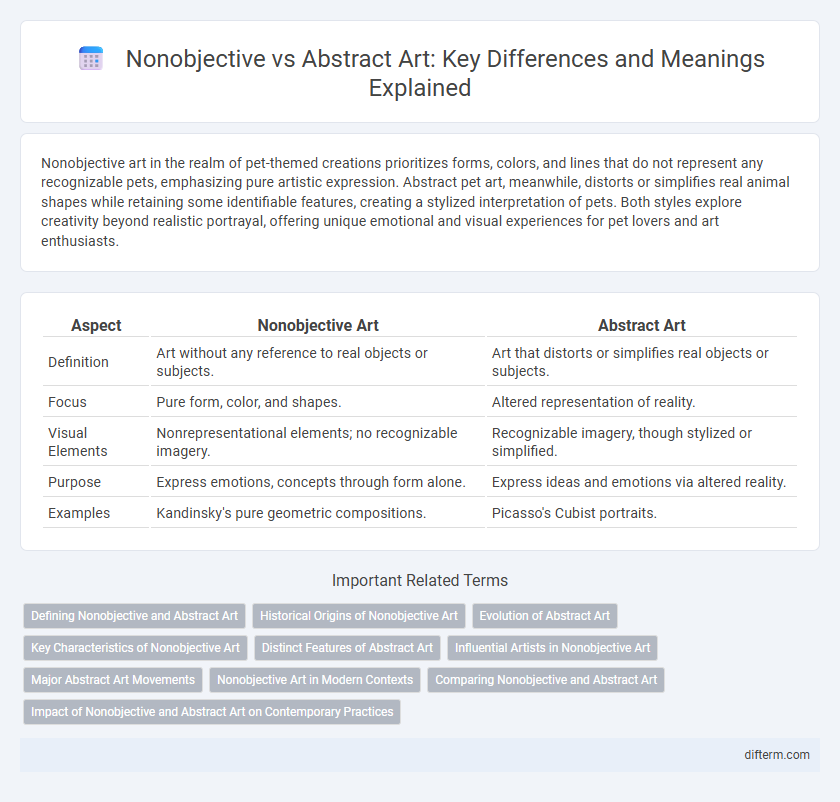Nonobjective art in the realm of pet-themed creations prioritizes forms, colors, and lines that do not represent any recognizable pets, emphasizing pure artistic expression. Abstract pet art, meanwhile, distorts or simplifies real animal shapes while retaining some identifiable features, creating a stylized interpretation of pets. Both styles explore creativity beyond realistic portrayal, offering unique emotional and visual experiences for pet lovers and art enthusiasts.
Table of Comparison
| Aspect | Nonobjective Art | Abstract Art |
|---|---|---|
| Definition | Art without any reference to real objects or subjects. | Art that distorts or simplifies real objects or subjects. |
| Focus | Pure form, color, and shapes. | Altered representation of reality. |
| Visual Elements | Nonrepresentational elements; no recognizable imagery. | Recognizable imagery, though stylized or simplified. |
| Purpose | Express emotions, concepts through form alone. | Express ideas and emotions via altered reality. |
| Examples | Kandinsky's pure geometric compositions. | Picasso's Cubist portraits. |
Defining Nonobjective and Abstract Art
Nonobjective art emphasizes shapes, colors, and forms with no reference to recognizable objects, creating purely visual experiences detached from reality. Abstract art, while also departing from realistic depiction, retains some elements inspired by real-world subjects, transforming them through distortion or simplification. Understanding this distinction highlights how nonobjective art prioritizes pure aesthetics, whereas abstract art balances abstraction with representational roots.
Historical Origins of Nonobjective Art
Nonobjective art, emerging in the early 20th century, is characterized by the absence of recognizable subject matter, distinguishing it from abstract art, which often simplifies or distorts real-world objects. Pioneers like Wassily Kandinsky and Kazimir Malevich played crucial roles in establishing nonobjective art through their emphasis on pure form, color, and composition. Rooted in movements such as Suprematism and De Stijl, nonobjective art marked a radical departure from representational traditions, focusing solely on the intrinsic qualities of the medium.
Evolution of Abstract Art
The evolution of abstract art traces its roots from early 20th-century movements where artists like Wassily Kandinsky and Kazimir Malevich pioneered nonobjective compositions focusing on color, form, and gesture rather than representational content. Abstract art evolved by incorporating symbolic and emotional elements, differentiating from purely nonobjective work that emphasizes geometric shapes and spatial relationships without external references. This progression highlights the transition from strict nonfigurative forms to more expressive abstraction, reflecting broader artistic and cultural shifts.
Key Characteristics of Nonobjective Art
Nonobjective art is characterized by the absence of recognizable objects or subjects, emphasizing pure form, color, and line to evoke emotions or ideas. It prioritizes geometric shapes, dynamic compositions, and a focus on spatial relationships rather than representational accuracy. This art form often explores concepts of balance, rhythm, and movement without relying on naturalistic references.
Distinct Features of Abstract Art
Abstract art emphasizes recognizable shapes and forms that are distorted or exaggerated, whereas nonobjective art lacks any reference to real-world objects. Distinct features of abstract art include the use of color, line, and texture to represent emotions or concepts while maintaining a connection to reality. This form often explores balance and composition through simplified or fragmented imagery, creating a bridge between representation and pure abstraction.
Influential Artists in Nonobjective Art
Wassily Kandinsky is a seminal figure in nonobjective art, pioneering compositions that emphasize color, form, and emotion without reference to physical objects. Hilma af Klint's innovative works predate much of the abstract movement, utilizing symbolic shapes and spiritual themes in pure abstraction. Kazimir Malevich's Suprematism advanced geometric nonobjective art, promoting the supremacy of pure artistic feeling over visual representation.
Major Abstract Art Movements
Nonobjective art eliminates recognizable subjects, emphasizing color, form, and texture to evoke emotion, exemplified by movements like Abstract Expressionism and Color Field painting. Abstract art retains a connection to reality while distorting or simplifying figures, seen in Cubism and Futurism, which explore fragmented perspectives and dynamic forms. Major abstract art movements pioneered visual language that challenges traditional representation, shaping modern artistic expression.
Nonobjective Art in Modern Contexts
Nonobjective art eliminates recognizable subjects, emphasizing color, form, and texture to evoke emotional or intellectual responses. In modern contexts, nonobjective art challenges traditional representation and encourages viewers to engage with pure visual elements. This approach aligns with contemporary movements that prioritize innovation and personal interpretation over figurative accuracy.
Comparing Nonobjective and Abstract Art
Nonobjective art eliminates recognizable subject matter entirely, emphasizing shapes, colors, and forms to evoke emotions or ideas without referencing the physical world. Abstract art, while also distorting or simplifying real objects, retains some connection to recognizable forms, allowing viewers to interpret the work through familiar visual cues. The distinction lies in nonobjective art's complete detachment from reality versus abstract art's transformation of real-world elements.
Impact of Nonobjective and Abstract Art on Contemporary Practices
Nonobjective art, characterized by the absence of recognizable subjects, challenges traditional representation and encourages viewers to engage with pure form, color, and texture, profoundly influencing contemporary minimalist and conceptual art practices. Abstract art, which distorts or simplifies real-world elements, has expanded the boundaries of expression, inspiring diverse techniques in digital media, installation, and performance art. Both movements have driven innovation by emphasizing emotional resonance and subjective interpretation, reshaping the landscape of modern artistic creation.
nonobjective vs abstract Infographic

 difterm.com
difterm.com